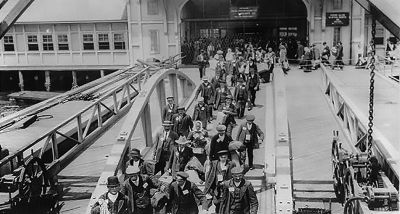Quest’articolo parla della difficoltà che avevano gli immigrati irlandesi quando vennero negli stati uniti dopo la fame del 1840. Gli irlandesi riscontrarono discriminazione, mancanza di lavoro e di un tetto, e molta sfortuna. Quando arrivarono gli italiani, riscontrarono le stesse cose degli irlandesi. I due gruppi di immigrati hanno dovuto cambiare i loro cognomi per nascondere la loro etnia. Purtroppo, gli irlandesi e gli italiani ebbero molta competizione per il lavoro, nelle chiese per la religione, e per il potere nelle comunità. Allora c’erano dei problemi fra questi due gruppi perché non riuscivano a lavorare insieme. Piano piano, accorgendosi di avere gli stessi problemi e di poter lavorare insieme per migliorare le loro vite, collaborarono per avere una grande influenza nelle città e affermare il potere su diverse strade.
Mass immigration changed the face of America forever. The tidal wave of immigrants coming to America from Europe (1880-1910) transformed an English-dominated, American culture into a melting pot of refugees and renegades in search of new opportunities and a new way of life. "When Irish, German, Italian and other European immigrants came to the United States during a wave of immigration at the turn of the 20th century, captivated by the promise that all immigrants can be transformed into Americans, a new alloy forged in the crucible of democracy, freedom, and civic responsibility," writes Gary Marx in “Sixteen Trends: Their Profound Impact on Our Future.”
For the Italian and Irish immigrants, the massive surge into America's port cities was far from a welcoming experience. Many were hungry and homeless leaving thousands of the early Irish wondering and asking themselves, “is America really the land of opportunity?” The treatment of Irish immigrants was especially detestable. They were discriminated against, being called savages and drunkards, reducing them to social outcasts. Likewise, the treatment of Italian immigrants was just as disturbing. In many cases, Italians were also shunned and discriminated against and callously called dagoes, wops, and guineas. By necessity, Italian and Irish immigrants became fighters for opportunity and against oppression. There were no other options.
The Irish were the first big wave of immigrants coming to America after the potato famine in Ireland in the 1840s. Their story was treacherously enduring before eventually becoming triumphant. “‘No Irish Need Apply,’ a famous folk song of the common school period, referred to rental and employment signs telling Irish Americans they were not welcomed as residents and workers," writes Joel Spring, in “The American School: A Global Context from the Puritans to the Obama Era.” To gain employment, many Irish Americans renamed themselves to English-sounding names, often omitting the ‘O’ or ‘Mc’ at the beginning of their names hoping to mask their Irish origins. Many Italian immigrants also changed their names to hide their Italian identity. In a Niagara Falls factory in 1959, an applicant with a last name of Benevenuto changed his name to Benton to secure union employment.
When large numbers of Italians began arriving in NYC around 1880, they faced fierce competition from the Irish who resented them working for less money and longer hours. In those days, they fought over jobs or turf and jockeyed for power in church, politics, unions, and in civil service. “They clashed in parishes, workplaces, neighborhoods, and politics. But over time, these same arenas came to unite them. The Italians had no choice but to deal with the Irish, who were their union leaders, foremen, schoolteachers, cops, and ward heelers…The Irish had to deal with the Italians if they were to raise the status of the Catholic faith in Protestant America,” writes Paul Moses in “The Love-Hate Story of New York’s Irish and Italians.” After decades of rumbling and constantly competing, Italians and Irish began working together as partners in community projects.
As the Irish demographic grew, they began to achieve success in the workplace, especially in the labor and trade union movement. Large Irish populations in big cities like Boston, Chicago and New York paved the way for the election of Irish candidates to public offices, launching the genesis of Irish political organizations in municipalities. Italian city planners, engineers, builders, and tradesmen benefitted in the remaking of a new America. “Yet, in the years after WWII, the church played a key role in bringing the Irish and Italians together, and to the altar in marriage. This is the very American story of the Irish and Italians: when people from once-warring tribes mingle and get to know each other as equals, the social barriers fall away,” writes Moses.
“Following WWII, Italians who married a non-Italian partner nearly always married someone of Irish ancestry. And the Italians who married Irish spouses generally went to Catholic schools and were regular churchgoers.” The changing cultural attitudes are depicted in the Oscar-nominated film “Brooklyn” when Italian Tony Fiorello brings Ellis Lacey, a young Irishman, to his home for dinner. The film is a magically produced, love-hate story of New York’s Irish and Italians.
Irish and Italian Americans once detested each other and remarkably changed it all for the good of America. They deserve tremendous credit and recognition for their spirit and determination to succeed in a hostile new world that they believed from the onset was going to be the land of opportunity.
The early Italians and Irish survived, adapted and succeeded, and today's America continues to be better for it. Together, they found the Catholic faith and intermarriage as the best-blessed bridges, the conduits, to accepting and understanding each other better, curing social maladies for all people to emulate.



